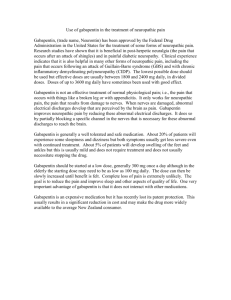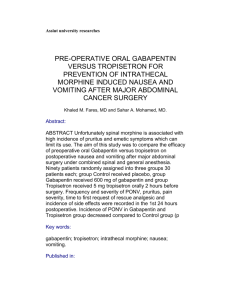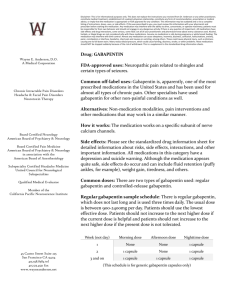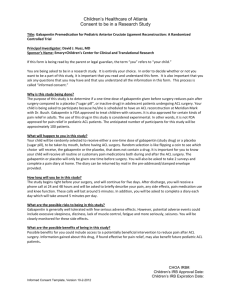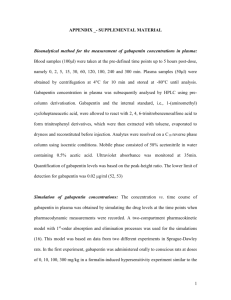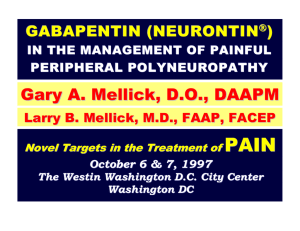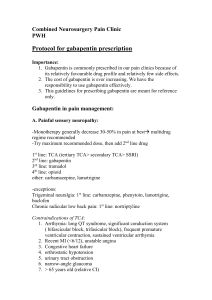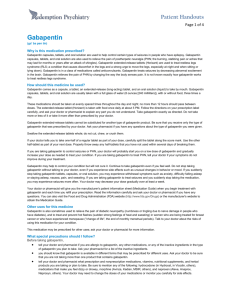In our study data was entered into statistical package for social
advertisement
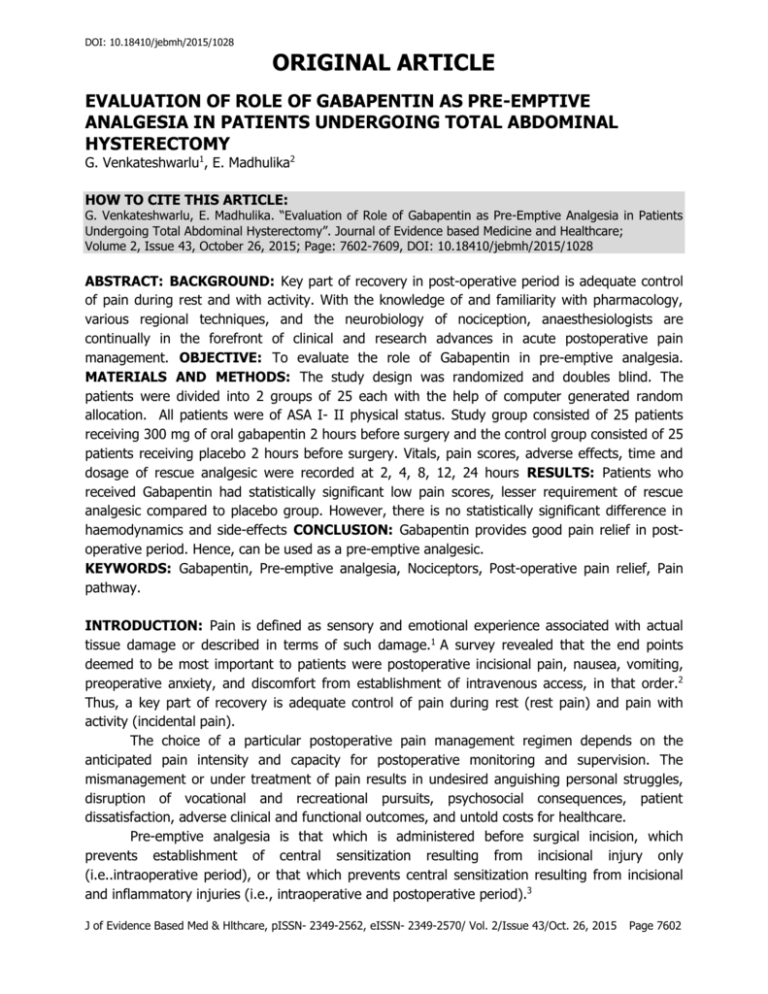
DOI: 10.18410/jebmh/2015/1028 ORIGINAL ARTICLE EVALUATION OF ROLE OF GABAPENTIN AS PRE-EMPTIVE ANALGESIA IN PATIENTS UNDERGOING TOTAL ABDOMINAL HYSTERECTOMY G. Venkateshwarlu1, E. Madhulika2 HOW TO CITE THIS ARTICLE: G. Venkateshwarlu, E. Madhulika. “Evaluation of Role of Gabapentin as Pre-Emptive Analgesia in Patients Undergoing Total Abdominal Hysterectomy”. Journal of Evidence based Medicine and Healthcare; Volume 2, Issue 43, October 26, 2015; Page: 7602-7609, DOI: 10.18410/jebmh/2015/1028 ABSTRACT: BACKGROUND: Key part of recovery in post-operative period is adequate control of pain during rest and with activity. With the knowledge of and familiarity with pharmacology, various regional techniques, and the neurobiology of nociception, anaesthesiologists are continually in the forefront of clinical and research advances in acute postoperative pain management. OBJECTIVE: To evaluate the role of Gabapentin in pre-emptive analgesia. MATERIALS AND METHODS: The study design was randomized and doubles blind. The patients were divided into 2 groups of 25 each with the help of computer generated random allocation. All patients were of ASA I- II physical status. Study group consisted of 25 patients receiving 300 mg of oral gabapentin 2 hours before surgery and the control group consisted of 25 patients receiving placebo 2 hours before surgery. Vitals, pain scores, adverse effects, time and dosage of rescue analgesic were recorded at 2, 4, 8, 12, 24 hours RESULTS: Patients who received Gabapentin had statistically significant low pain scores, lesser requirement of rescue analgesic compared to placebo group. However, there is no statistically significant difference in haemodynamics and side-effects CONCLUSION: Gabapentin provides good pain relief in postoperative period. Hence, can be used as a pre-emptive analgesic. KEYWORDS: Gabapentin, Pre-emptive analgesia, Nociceptors, Post-operative pain relief, Pain pathway. INTRODUCTION: Pain is defined as sensory and emotional experience associated with actual tissue damage or described in terms of such damage.1 A survey revealed that the end points deemed to be most important to patients were postoperative incisional pain, nausea, vomiting, preoperative anxiety, and discomfort from establishment of intravenous access, in that order.2 Thus, a key part of recovery is adequate control of pain during rest (rest pain) and pain with activity (incidental pain). The choice of a particular postoperative pain management regimen depends on the anticipated pain intensity and capacity for postoperative monitoring and supervision. The mismanagement or under treatment of pain results in undesired anguishing personal struggles, disruption of vocational and recreational pursuits, psychosocial consequences, patient dissatisfaction, adverse clinical and functional outcomes, and untold costs for healthcare. Pre-emptive analgesia is that which is administered before surgical incision, which prevents establishment of central sensitization resulting from incisional injury only (i.e..intraoperative period), or that which prevents central sensitization resulting from incisional and inflammatory injuries (i.e., intraoperative and postoperative period).3 J of Evidence Based Med & Hlthcare, pISSN- 2349-2562, eISSN- 2349-2570/ Vol. 2/Issue 43/Oct. 26, 2015 Page 7602 DOI: 10.18410/jebmh/2015/1028 ORIGINAL ARTICLE Inhibition of afferent pain pathways by use of local anesthetic blocks, altered perception of pain with opioid use, and inhibition of pain pathways by NMDA receptor antagonists are examples of pre-emptive analgesia. Using a combination of pre-emptive modalities and addressing patients' perceptions can aid in interrupting pathologic pain cycles. Maximal clinical benefit is seen when there is complete blockade of noxious stimuli with extension of this block into the postoperative period.4 By preventing central sensitisation pre-emptive analgesia along with intensive multimodal analgesic interventions may reduce acute postoperative pain and chronic pain after surgery.5,6 Poorly controlled acute postoperative pain maybe an important factor in the development of pathologic long-term chronic pain after surgery.5,7The effective management of post-operative pain is not only humane but is a very important aspect of post-operative care. Hence, in our study we tried to evaluate the role of Gabapentin as pre-emptive analgesic. PAIN PATHWAY: Noxious stimuli → by Aδ and C fibres (first order neurons) → dorsal horn of spinal cord → second order neuron → Thalamus → cerebral cortex. Pre-emptive analgesia aims at preventing both peripheral and central sensitization thereby attenuating (or, ideally, preventing) the post-operative amplification of pain sensation. Treatment can be aimed at the periphery, at inputs along sensory axons. Or at CNS sites using single or combinations of analgesics applied either continuously or intermittently. GABAPENTIN: Gabapentin is described as 1-(aminomethyl) cyclohexaneacetic acid. In general, laboratory and clinical data confirm evidence that the noxius input from the neuropathic pain focus resembles abnormal epileptiform activity.8,9,10 Not only does Gabapentin increase GABA levels,11 it also decreases levels of the primary neurotransmitter Glutamate and has positive pain actions at N and P calcium channel.12,13 Gabapentin does not act directly on GABA receptors, but modify the synaptic or nonsynaptic release of GABA. Gabapentin binds avidly to the α2 δ subunit of voltage gated calcium channels. This appears to underlie the main mechanism of action, which is decreased calcium entry, a predominant effect on presynaptic N-type channels.11 In vitro studies with radiolabeled gabapentin have revealed a gabapentin binding site in areas of rat brain including neocortex and hippocampus. AIM OF THE STUDY: To investigate the effect of gabapentin administered 2 hours before surgery (pre-emptive) on post-operative analgesia and total opioid consumption in patients undergoing Total Abdominal Hysterectomy (TAH) under regional anaesthesia (Spinal anesthesia). MATERIALS AND METHODS: The present clinical study was conducted at Gandhi medical college and Gandhi Hospital, Secunderabad. After getting institutional approval, written and informed consent was taken from each patient. The study design was randomized and doubles blind. The patients were divided into 2 groups of 25 each with the help of computer generated random allocation. J of Evidence Based Med & Hlthcare, pISSN- 2349-2562, eISSN- 2349-2570/ Vol. 2/Issue 43/Oct. 26, 2015 Page 7603 DOI: 10.18410/jebmh/2015/1028 ORIGINAL ARTICLE Study group 25 patients 300 mg of oral gabapentin 2 hours before surgery Control group 25 patients placebo 2 hours before surgery Inclusion criteria: 50 patients of ASA status I and II undergoing elective Total Abdominal Hysterectomy between age group 30 - 50 years of age were selected for the study. Exclusion criteria: Patients with known allergy to Gabapentin, suffering from epilepsy, previous treatment with gabapentin, suffering from any chronic pain syndrome, having psychiatric illness or with impaired kidney or liver function and patients who had received analgesics within 48 hrs before surgery were excluded from the study. Patients with blockade more than T 6 or inadequate blockade, supplemented with intraoperative analgesics were excluded from the study. A physician not involved in this study prepared two kits; kit A containing the study drug (Gabapentin 300mg) and kit B containing placebo which looked similar to Gabapentin and divided the patients into two groups randomly. The medication was given orally with sips of water about two hours preoperatively by a staff nurse. The patients were instructed on the use of Visual Analogue Scale. Preanaesthetic check-up was conducted a day before to obtain a detailed history and complete clinical examination was done. Routine investigations were done. After confirming the NBM status the patient was shifted to operating room. Routine monitoring with pulse oximetry, NIBP, ECG, Urine Output with an indwelling catheter was initiated in the Operation Theater. All patients were preloaded with 10 ml /kg of lactated Ringer’s solution and Lumbar puncture was performed at L3 - L4 space under full aseptic precautions and after free flow of clear CSF 3.25 ml (16.25 mg) of Hyperbaric solution of 0.5 % Bupivacaine was given in sub arachnoid space and the patients were turned supine. Successful sensory blockade up to T6 was confirmed with pin-prick. Intra operatively patients vitals are monitored for every 5 minutes. After surgery patients were shifted to recovery room. A physician who was not aware of the group allocation had recorded the following parameters at 2, 4, 8, 12, 24 hours: 1) Visual Analogue Scale: pain scores (0 - means no pain, 10 - worst imaginable pain.) 2) Heart rate, Blood pressure, SpO2 3) The time from the end of surgery until the 1st dose of rescue analgesic administered on demand. J of Evidence Based Med & Hlthcare, pISSN- 2349-2562, eISSN- 2349-2570/ Vol. 2/Issue 43/Oct. 26, 2015 Page 7604 DOI: 10.18410/jebmh/2015/1028 ORIGINAL ARTICLE 4) Adverse effects ( nausea, somnolence, fatigue, vertigo, ataxia, tremors, diplopia ) 5) The total rescue analgesic requirement in 1st 24 hrs. OBSERVATION AND RESULTS: The present study was undertaken on 50 ASA grade I and II patients aged between 30 to 50 years posted for elective total abdominal hysterectomy. STATISTICAL ANALYSIS: In our study data was entered into statistical package for social sciences (SPSS) version 14.0 and statistical analysis was done using paired sample t test. Data was expressed as mean ± Standard Deviation, probability values <0.001 were considered as statistically significant. The groups were compared for physical characteristics (age, weight), pain scores (Visual Analogue Scale), hemodynamic values referring to pulse rate and mean arterial blood pressure, time when the first dose of rescue analgesic was asked, total number of times the rescue analgesic was asked in the first 24 hours postoperatively and presence of side effects, if any. Age (years ) Weight ( kg) (Mean ± SD) (Mean ± SD) 44.16 ± 5.37 60.36 ± 4.59 41.8 ± 5.14 59.16 ± 4.59 Table 1: Demographic data Group A B The age and weight distribution of patients in both the groups were similar. Group A B 2 hours (Mean ± SD) 2.2 ± 0.70 3.8 ± 1 4 hours 8 hours 12 hours (Mean ± SD) (Mean ± SD) (Mean±SD) 4.2 ± 0.86 2.6 ± 0.57 2.8 ± 0.74 6.52 ± 1.08 3.88 ± 0.78 2.52 ± 0.65 Table 2: Visual Analogue scale scores 24 hours (Mean± SD) 3.4 ± 0.81 3.2 ± 0.71 J of Evidence Based Med & Hlthcare, pISSN- 2349-2562, eISSN- 2349-2570/ Vol. 2/Issue 43/Oct. 26, 2015 Page 7605 DOI: 10.18410/jebmh/2015/1028 ORIGINAL ARTICLE The pain scores in group A (gabapentin) were significantly (p <0.001) lower at 2 hours, 4 hours and 8 hours post operatively, as compared to group B (placebo ). There was no significant difference at 12 and 24 hours. Group A B 2 hours 4 hours 8 hours 12 hours 24 hours (Mean±SD) (Mean±SD) (Mean±SD) (Mean±SD) (Mean±SD) 83.44 ± 9.63 84.64 ± 9.23 82.32 ± 8.91 81.28 ± 8.7 84.72 ± 8.8 83.92 ± 8.0 90.12 ± 9.09 85.12 ± 7.0 81.84 ± 6.10 85.76 ± 8.96 Table 3: Pulse Rate (beats/minute) The pulse rate was similar in both the groups with a slight increase at 4 hours and 8 hours post operatively in the placebo group which was not statistically significant (p >0.001) Group A B 2 hours 4 hours 8 hours 12 hours 24 hours (Mean±SD) (Mean±SD) (Mean±SD) (Mean±SD) (Mean±SD) 97.04±10.14 99.52±8.96 96.84±9.23 95.04±7.71 98.4±6.73 95.16±7.26 103.48±7.25 97.88±9.54 93.6±9.81 99.44±10.35 Table 4: Mean arterial pressure (mm of Hg) Mean arterial pressure was similar in both the groups except at 4 hours, there was an increase in Mean Arterial Pressure in the placebo group which was statistically not significant (p>0.001). Group Time ( minutes) (Mean ± SD) A 320.4 ± 37.35 B 257 ± 23.00 Table 5: Time when first dose of analgesic was asked Patients in the placebo group (group B) asked for the rescue analgesic earlier than the gabapentin group (group A) which was statistically significant (p<0.001). Number of times rescue analgesic required (Mean±SD) Group A 2.12 ± 0.67 Group B 2.88 ± 0.33 Table 6: Number of times rescue analgesic asked with in first 24 hours postoperatively Group The number of times rescue analgesic (tramadol 2mg/kg) asked by the patients in gabapentin group was significantly less (p<0.001) as compared to the number of times asked by the patients in the placebo group. J of Evidence Based Med & Hlthcare, pISSN- 2349-2562, eISSN- 2349-2570/ Vol. 2/Issue 43/Oct. 26, 2015 Page 7606 DOI: 10.18410/jebmh/2015/1028 ORIGINAL ARTICLE Side Effect Group A Group B Nausea 2 1 Vomiting 1 0 Light headedness 1 1 somnolence 1 0 Table 7: Adverse effects There was no statistically significant difference (p>0.001) in the side effects experienced by the patients in both the groups. DISCUSSION: This study was conducted to evaluate the effect of pre-emptive Gabapentin (300mg) on the duration of postoperative analgesia and consumption of opioid in the postoperative period in 50 patients of ASA status I and II undergoing elective total abdominal hysterectomy between age group 30–50 years. In our study we selected patients who were posted for elective total abdominal hysterectomy, who did not have any presurgical pain and we found that pre-emptive analgesia was effective in these patients. In our study pain was evaluated using visual analogue scale scores. We found that pain scores were significantly lower in the study group when compared to the placebo group up to first 8hrs postoperatively, with the maximum VAS scores at 4hrs in both the groups. At 12 and 24 hrs postoperatively there was no significant difference between the two groups. By decreasing the altered central sensory processing, pre-emptive analgesia in the form of Gabapentin is thought to consequently decrease the incidence of hyperalgesia and allodynia after surgery. Similar results were seen in a study by Takmaz SA et al.,14 where the VAS scores at rest during the first 6hrs postoperatively and at movement during first 8hrs postoperatively were significantly lower in patients who received Gabapentin. Similarly Turan et al.,15 also found that pain scores were significantly lower in the gabapentin group up to 4 hrs. After the surgery In a study by Turan A et al16, 17 there was not much difference between the study and the control group in the hemodynamic variables like heart rate and mean blood pressure at any time in the postoperative period, which was similar to our study on haemodynamics, In our study the time from the end of surgery until the first dose rescue analgesic was administered on demand was found to be significantly more in the gabapentin group as compared to the placebo group. Similar results were found by Montazeri K et al18 and Grover V K et al.,19 in their respective studies. Similarly Sen H et al found20 in their study that the total tramadol consumption up to 24 hrs. after the surgery was significantly less in the gabapentin group when compared to placebo group. Similar results were found in our study with a reduction in the total tramadol consumption though we did not measure the plasma levels of gabapentin. Our study results correlated with the above studies with the number of times the rescue analgesic asked by the patients in the gabapentin group being significantly less than that asked by the patients in the placebo group J of Evidence Based Med & Hlthcare, pISSN- 2349-2562, eISSN- 2349-2570/ Vol. 2/Issue 43/Oct. 26, 2015 Page 7607 DOI: 10.18410/jebmh/2015/1028 ORIGINAL ARTICLE thereby reducing the total tramadol consumption in the first 24 hrs postoperatively in the study group. In our study there was no statistically significant difference in the overall incidence of adverse effects although the incidence of nausea / vomiting was slightly more in the study group than in the control group. Similar results were found by Montazeri K et al.,18 and Anil Verma et al.,21 in their respective studies with nausea / vomiting being the common side–effects in the gabapentin group though there was no statistically significant increase in the frequency of adverse effects. CONCLUSION: In the above study, following conclusions can be made: There was significant pain relief with gabapentin upto 8 hours post operatively. Gabapentin does not cause any significant changes in hemodynamic variables ( pulse rate, mean arterial pressure) Gabapentin significantly prolongs the duration of analgesia Gabapentin significantly reduces the consumption of tramadol in the first 24 hours post operatively Gabapentin does not cause any significant side effects. In conclusion, it can be said that pre-emptive Gabapentin provides significant pain relief in early post-operative period with reduction in opioid consumption. REFERENCES: 1. Mersky H, Bogduk M: Classification of chronic pain: Descriptions of chronic pain syndromes and definitions of pain terms. Seattle, WA, IASP Press, 1994. 2. Macario A, Weinger M, Truong P, et al: which clinical anesthesia outcomes are both common and important to avoid? The perspective of a panel of expert anaesthesiologists. Anesth Analg 1999, 88: 1085. 3. Kissin I: Preemptive Analgesia. Anesthesiology 2000, 93: 1138. 4. Kissin I, Lee SS, Bradley EL Jr: Effect of prolonged nerve block on inflammatory hyperalgesia in rats: Prevention of late hyperalgesia. Anesthesiology 1998, 88: 224. 5. Perkins FM, Kehlet H: Chronic pain as an outcome of surgery. A review of predictive factors. Anesthesiology 2000, 93: 1123. 6. Obata H, Saito S, Fujita N, et al: Epidural block with Mepivacaine before surgery reduces longterm post – thoracotomy pain. Can J Anaesth 1999, 46: 1127. 7. Macrae WA: Chronic pain after surgery. Br J Anaesth 2001, 87: 88. 8. Backonja MM: defining neuropathic pain. Anesth Analg 2003, 97: 785. 9. Bolay H, Moskowitz MA: Mechanism of pain modulation in chronic syndromes. Neurology 2002, 59: 52. 10. Backonja MM: Use of anticonvulsants for treatment of neuropathic pain. Neurology 2002, 59: 514. 11. Roger J, Brian S. Meldrum. Antiseizure drugs. In: Bertram G. Katzung. Basic and clinical pharmacology, The Mc Graw –Hill companies. 10th Ed. 2007. 385. J of Evidence Based Med & Hlthcare, pISSN- 2349-2562, eISSN- 2349-2570/ Vol. 2/Issue 43/Oct. 26, 2015 Page 7608 DOI: 10.18410/jebmh/2015/1028 ORIGINAL ARTICLE 12. Rosner H, Rubin L, Kestenbaum A: Gabapentin adjunctive therapy in neuropathic pain sites. Clin J Pain 1996, 12: 56. 13. Field MJ, Oles RJ, Lewis AS, Mc clear S, et al: Gabapentin (Neourontin) and S-3– isobutylgaba represent a novel class of selective antihyperalgesic agents. Br J Pharmacol 1997, 121: 1513. 14. Takmaz SA, Kaymak C, Pehlivan BS, Dikmen B. Effect of preoperative 900 and 1200 mg single oral dose of Gabapentin on postoperative pain relief and Tramadol consumption in open cholecystectomy surgery. Agri. 2007; 19 (3): 32. 15. Phillips DM; JCAHO pain management standards are unveiled. JAMA 2000, 284: 428. 16. Turan A, Karamanlioğlu B, Memiş D, Usar P, Pamukçu Z, Türe M. The analgesic effects of gabapentin after total abdominal hysterectomy. Anesth Analg. 2004; 98 (5): 1370. 17. Turan A, Karamanlioğlu B, Memiş D, Hamamcioglu MK, Tükenmez B, Pamukçu Z, Kurt I. Analgesic effects of gabapentin after spinal surgery. Anesthesiology. 2004; 100 (4): 935. 18. Montazeri K, Kashefi P, Honarmand A. Pre-emptive Gabapentin significantly reduces postoperative pain and morphine demand following lower extremity orthopaedic surgery. Singapore Med J. 2007; 48 (8): 748. 19. Grover VK, Mathew PJ, Yaddanapudi S, Sehgal S. A single dose of preoperative Gabapentin for pain reduction and requirement of morphine after total mastectomy and axillary dissection: Randomized placebo-controlled double-blind trial. J Postgrad Med. 2009; 55 (4): 25. 20. Sen H, Sizlan A, Yanarateş O, Senol MG, Inangil G, Sücüllü I, Ozkan S, Dağli G. The effects of gabapentin on acute and chronic pain after inguinal herniorrhaphy. Eur J Anaesthesiol. 2009; 26 (9): 772. 21. Anil Verma, Sangeeta Arya, Sandeep Sahu, Indu Lata, HD Pandey, Harpreet Singh. To evaluate the role of Gabapentin as preemptive analgesic in patients undergoing total abdominal hysterectomy in epidural anaesthesia. Indian J Anaesth 2008; 52 (4): 428. AUTHORS: 1. G. Venkateshwarlu 2. E. Madhulika PARTICULARS OF CONTRIBUTORS: 1. Professor, Department of Anaesthesiology and Critical Care, Gandhi Medical College, Hyderabad, Telangana, India. 2. Professor, Department of Anaesthesiology and Critical Care, Gandhi Medical College, Hyderabad, Telangana, India. NAME ADDRESS EMAIL ID OF THE CORRESPONDING AUTHOR: Dr. G. Venkateshwarlu, C/o. M. Bhanu Lakshmi, Tulip 26, L&T Serene County, Gachibowli, Hydrerabad-500032. E-mail: profkmc@yahoo.com Date Date Date Date of of of of Submission: 07/10/2015. Peer Review: 08/10/2015. Acceptance: 13/10/2015. Publishing: 21/10/2015. J of Evidence Based Med & Hlthcare, pISSN- 2349-2562, eISSN- 2349-2570/ Vol. 2/Issue 43/Oct. 26, 2015 Page 7609
